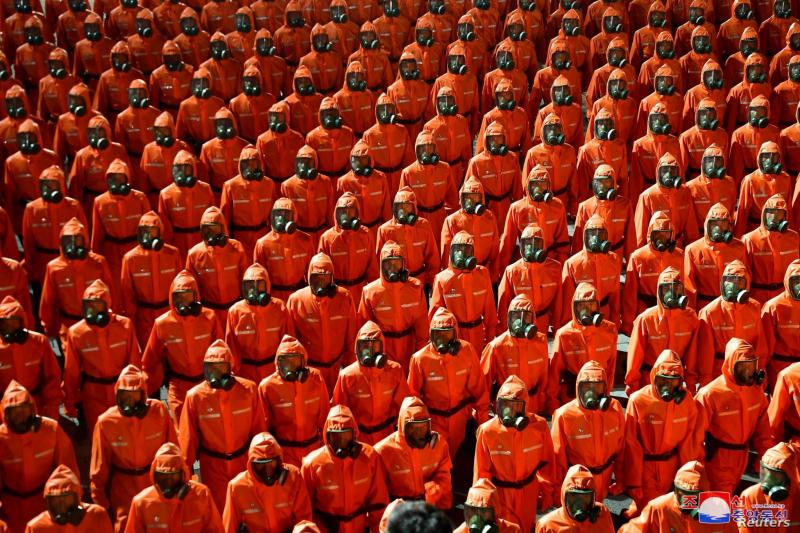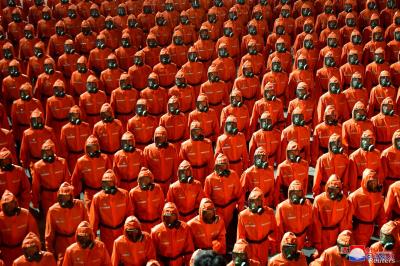The situation in North Korea has changed since the outbreak of the coronavirus pandemic, and for the past two and a half years, a sense of calm has descended upon Pyongyang, adding to the uncertainty of the internal situation. On the occasion of its founding anniversary, North Korea organized a "less provocative" display, according to AFP, which included members from the Ministry of Railways, Air Koryo, and the Hongnam Fertilizer Complex, without any mention of strategic weapon displays. Kim appeared before the crowds and greeted the people.
North Korea has not reported any confirmed cases of COVID-19, according to Reuters, but it has closed its borders and imposed strict preventive measures, considering the pandemic a threat to national sovereignty, which has increased pressure on its already struggling economy. North Korea closed its borders even to its main trading partner, China, a step that the UN human rights organization stated has exacerbated shortages of food and medical supplies in Pyongyang.
The border closures have also made it difficult to access direct information sources from the country, which previously helped policymakers make informed decisions and understand internal pressures and problems, especially the information that "shaped U.S. policy towards the nuclear-armed North Korean regime," according to the Washington Post. The closures led to a "mass exodus" of foreigners, diplomats, aid workers, business envoys, and journalists who could verify reports by state media. These individuals were crucial sources for policymakers on how to negotiate and engage North Korea to curtail its ever-increasing nuclear ambitions and gain a "deeper understanding of the dynamics" guiding the political calculations of the North Korean leader.
Susan DiMagio, a senior fellow at the Carnegie Endowment for International Peace and an expert in diplomatic negotiations, stated, "Attempting to formulate sound decisions without direct internal sources is akin to stumbling in the dark." Analysts say that North Korea takes the pandemic with an almost insane seriousness, with Pyongyang being extremely stringent regarding its borders, to the extent of ordering the shooting of any intruders, including animals, without warning. South Korean military officials reported that last month North Korea shot a South Korean official who had gone missing from a fishing boat, and later doused the man's body in oil and set it ablaze, an action perceived as part of its fight against the coronavirus.
The recent military display held by North Korea was the first during President Joe Biden's administration, featuring groups wearing orange protective clothing and medical masks as a clear symbol of anti-coronavirus efforts, marching alongside soldiers carrying rifles.
### Move Towards Isolation
The Washington Post noted that these images provided "few glimpses" for the outside world to gather intelligence and new evidence about life under the North Korean regime. Most Western countries withdrew their diplomatic staff in early 2020 due to food and medicine shortages, while diplomats from some countries, including Russia, China, Syria, and Cuba, remained.
Moreover, the number of defections from Pyongyang has sharply declined, with only two North Koreans reaching South Korea in the second quarter of 2021, the lowest quarterly number in at least 18 years, further limiting narratives about life there. Robert Lollier, the English editor for Daily NK, based in Seoul but having sources within North Korea, stated that the crackdown on illegal cellphone use has disrupted communication channels that long circumvented state controls. Many defectors are unable to contact their families or send remittances.
Analysts argue that North Korea was moving toward isolation and self-reliance even before the pandemic, with indications that Kim Jong Un was pulling away from reliance on the outside world. They add that since late 2019, state media discussions about self-reliance have spread, and detailed comments and statements regarding foreign affairs have become scarce.
The military display marking North Korea's 73rd founding anniversary omitted ballistic missiles. Attendees, including Kim, did not wear masks to prevent the spread of COVID-19. Unlike in October, when he boasted about the country’s nuclear capabilities and showcased intercontinental ballistic missiles that hadn't been seen before during a military parade, Kim did not deliver a speech on this occasion. The official Korean Central News Agency reported that Kim appeared before the crowds at midnight during the fireworks display, "warmly greeting all the people of the country," without including excerpts from his speech. The leader seemed thinner than before.
The display featured some conventional weapons, including multiple rocket launchers and tractors carrying anti-tank missiles. No ballistic missiles were seen, nor were they mentioned in reports. The event included a display of agricultural tractors and fire trucks instead of tanks and missiles, as was customary.
### Boosting Morale
This display was the third within less than a year in this nuclear-armed nation, as reported by state media. However, it is rare for the regime to organize three displays in less than a year - with a military parade in January coinciding with the Workers' Party congress and another in October to celebrate the 75th anniversary of that institution.
At the end of August, the International Atomic Energy Agency noted "indications" that North Korea could have restarted a plutonium-producing reactor at the Yongbyon nuclear complex, expressing concern over this. North Korea has not conducted any nuclear tests or launched intercontinental ballistic missiles since 2017. Instead, the regime has sought to use displays to convey a "message to the international community" without risking escalation, according to Hong Min, a researcher at the Korea Unification Institute in Seoul, for AFP.
Pyongyang is subjected to various international sanctions due to its prohibited nuclear and ballistic missile programs. Hong added that "the North may feel the need to pressure the United States to return to the negotiating table." Negotiations over the nuclear issue with Washington have been stalled since the failed Hanoi summit between Kim Jong Un and former President Donald Trump.
A representative of President Joe Biden has repeatedly expressed a desire to meet with North Korean counterparts "anywhere and anytime." The Biden administration has promised to adopt a "pragmatic and calibrated approach" to diplomatic efforts aimed at getting Pyongyang to abandon its weapons program, which North Korea has never shown willingness to undertake. Internally, the display serves as an opportunity to boost morale and reinforce "the people’s solidarity with the regime," according to Hong Min.




